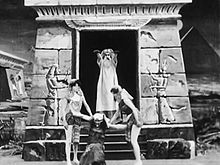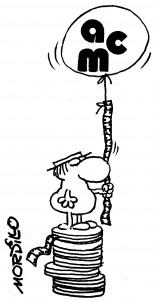
Georges Méliès, the first to have proposed the fantasy genre and the first to have used special effects in cinema thanks to his being an illusionist, was only interested in high quality works, and every time he made a film he realized two negatives, one for Europe and one for America. He used to film with two matched cameras. With the more recent adoption and systematic use of 3D technology in contemporary cinema, it was believed that finding copies of both the negatives would make it possible to obtain the stereoscopic effect, and so it was.
 Thanks to LOBSTER, a French company specialized in the restoration of films, it is possible to watch an “unconsciously” stereoscopic movie from 1903. Anyway, as stereoscopy had been known and widely used since the mid-19th century, this technique started to be experimentally used in the film making industry, as well. Italo Pacchioni, a pioneer from Milan, conceived his first camera already with the idea of 3D, although it was probably never practiced. The 3D attempt did not work in America, either, although two masters of the 20th century, Marcel Duchamp and Man Ray, had tried it it at the end of 1910. By using the “rotorelief” Duchamp, who had always been intrigued by research, had created a stereoscopic simulation with the only film he made: Anémic cinéma. In the ‘30s, the Lumière brothers had tried to develop a possible system for three-dimensional vision.
Thanks to LOBSTER, a French company specialized in the restoration of films, it is possible to watch an “unconsciously” stereoscopic movie from 1903. Anyway, as stereoscopy had been known and widely used since the mid-19th century, this technique started to be experimentally used in the film making industry, as well. Italo Pacchioni, a pioneer from Milan, conceived his first camera already with the idea of 3D, although it was probably never practiced. The 3D attempt did not work in America, either, although two masters of the 20th century, Marcel Duchamp and Man Ray, had tried it it at the end of 1910. By using the “rotorelief” Duchamp, who had always been intrigued by research, had created a stereoscopic simulation with the only film he made: Anémic cinéma. In the ‘30s, the Lumière brothers had tried to develop a possible system for three-dimensional vision.
This program, outlined together with Antonello Satta from the Italian Stereoscopic Archive, aims to make materials accessible to focus on the continuity of use and of refinement of this technology, which is able to make the audiovisual show more plausible and more similar to the three-dimensional bi-ocular vision.
Carlo Montanaro
Anaglyph glasses will be distributed for the screenings.
L’oracle de Delphes
Regia/Direction: Georges Méliès
Anno/Year: 1903
Durata/ Running time: 1’30”
Paese/Country: France
con/with: Georges Méliès (il ladro/the tief)
Anémic cinèma
Regia/Director: Marcel Duchamp
Anno/Year: 1926
Durata/Running time: 8’
Paese/Country: France
L’arrivée d’un trein en gare à la Ciotat
Regia/Director: Louis Lumière
Anno/Year: 1934
Paese/Country: France
Audioskopics
Regia/director: Jacob Leventhal, John Norling
Anno/Year: 1935
Durata/Running time: 8’
Paese/Country: USA
A Solid Explanation
Regia/Director: Peter Bradford
Anno/Year: 1951
Durata/Running time: 9’
Paese/Country: Great Britain
Come Closer
Regia/Director: Hy Hirsh
Anno/Year: 1952
Durata/Running time: 7’
Motor Rhythm
Regia/Director: John Norling
Anno/Year: 1953
Durata/Running time: 8’ 22’’
Paese/Country: USA
Looking of Perfection
Regia/Director: Rudy Bender
Anno/Year: 1985
Durata/Running time: 27’
Paese/Country: USA
